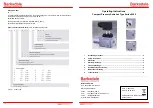
2-5
To improve security and avoid malicious attack to the unused SOCKETs, S4500 Ethernet switches
provide the following functions:
z
UDP 67 and UDP 68 ports used by DHCP are enabled only when DHCP is enabled.
z
UDP 67 and UDP 68 ports are disabled when DHCP is disabled.
The corresponding implementation is as follows:
z
When a VLAN interface is mapped to a DHCP server group with the
dhcp-server
command, the
DHCP relay agent is enabled. At the same time, UDP 67 and UDP 68 ports used by DHCP are
enabled.
z
When the mapping between a VLAN interface and a DHCP server group is removed with the
undo
dhcp-server
command, DHCP services are disabled. At the same time, UDP 67 and UDP 68
ports are disabled.
z
You can configure up to eight DHCP server IP addresses in a DHCP server group.
z
You can map multiple VLAN interfaces to one DHCP server group. But one VLAN interface can be
mapped to only one DHCP server group.
z
If you execute the
dhcp-server groupNo
command repeatedly, the new configuration overwrites
the previous one.
z
You need to configure the group number specified in the
dhcp-server groupNo
command in VLAN
interface view by using the command
dhcp-server groupNo
ip
ip-address&
<1-8> in advance.
Configuring DHCP Relay Agent Security Functions
Configuring address checking
After relaying an IP address from the DHCP server to a DHCP client, the DHCP relay agent can
automatically record the client’s IP-to-MAC binding and generate a dynamic address entry. It also
supports static bindings, which means you can manually configure IP-to-MAC bindings on the DHCP
relay agent, so that users can access external network using fixed IP addresses.
The purpose of the address checking function on DHCP relay agent is to prevent unauthorized users
from statically configuring IP addresses to access external networks. With this function enabled, a
DHCP relay agent inhibits a user from accessing external networks if the IP address configured on the
user end and the MAC address of the user end do not match any entries (including the entries
dynamically tracked by the DHCP relay agent and the manually configured static entries) in the user
address table on the DHCP relay agent.
Follow these steps to configure address checking:
To do…
Use the command…
Remarks
Enter system view
system-view
—
















































